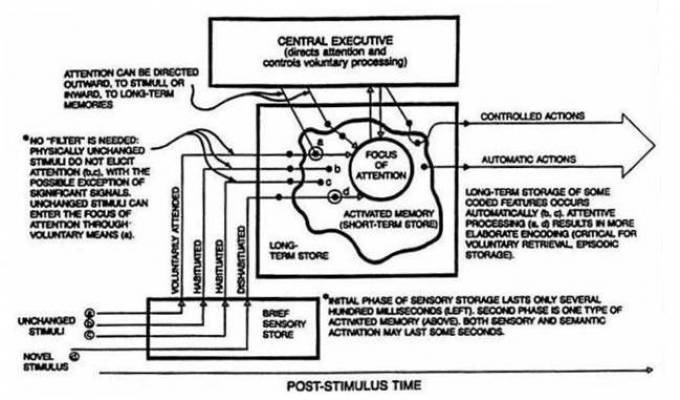This is an old revision of the document!
There are various, more or less similar definitions of the working memory, like1):
What is mostly common to these definitions is that they address working memory as the system which manipulates information from STM, (but sometimes also LTM)2). As this system is one of the key components in the process of knowledge acquisition, the most commonly discussed working memory models of Baddeley and Cowan will be briefly discussed here.
Based on experiments demonstrating connections between LTM and STM, as well as experiments indicating that STM consists of more components, Alan Baddeley and Graham Hitch proposed a multi-component working memory model in 19743). The new term working memory was supposed to emphasize the importance of this system in cognitive processing.4) Baddeley and Hitch suggested working memory is composed of three parts: the central executive, a system that controls the phonological loop (a subsystem for remembering phonological information such as language by constant refreshing through repetition in the loop), and the visuospatial sketch pad (a subsystem for storing visual information).
This model was later revised and improved by Baddeley5)6) but also contributed by other authors7), which resulted in additional component of episodic buffer8) in year 2000 and more detailed functions and analysis of other components, as described in table below.
| Central executive | It is still unclear weather it is a single system or more systems working together. Central executive's functions include attention and focusing, active inhibition of stimuli, planing and decision-making, sequencing, updating, maintenance and integration of information from phonological loop and visuospatial sketchpad. These functions also include communication with long-term memory and connections to language understanding and production centers. |
| Episodic buffer | Episodic buffer has the role of integrating the information from phonological loop and visuospatial sketchpad, but also from long-term memory. It serves as the storage component of central executive, or otherwise information integration wouldn't be possible. |
| Phonological loop | According to Baddeley, phonological loop consists of two components: a sound storage which lasts just a few seconds and an articulatory processor which maintains sound information in the storage by vocal or subvocal repetition. Verbal information seems to be automatically processed by phonological loop and it also plays an important, maybe even key role in language learning and speech production. It can also help in memorizing information from the visuospatial sketchpad. (For example, repeating “A red car is on the lawn.”) |
| Visuospatial sketchpad | This construct according to Baddeley enables temporary storing, maintaining and manipulating of visuospatial information. It is important in spatial orientation and solving visuospatial problems. Studies have indicated that visuospatial sketchpad might actually be containing two different systems: one for spatial information and processes and the other for visual information and processes. |
Nelson Cowan proposed a different model of working memory in 19889), the embeded-process model of working memory. Unlike Baddeley's model, which is concerned with modularity and components of the working memory, Cowan offered a view oriented mostly on underlying cognitive processes which occur when solving a task like language comprehension or production, problem-solving, decision-making and other.
 Cowan's model consists of four elements:
Cowan's model consists of four elements:
The activated memory consists of parts of long-term memory needed to preform or related to a cognitive task. Elements can be activated voluntarily or involuntarily. The amount of simultaneously active elements is still an issue of debate, but without rehearsing it has been shown that elements remain active for about 10 - 20 seconds. Working memory holds all of these activated elements, but only about 4±1 of them can be in focus, what is decided by voluntarily or involuntarily attention switching using the central executive.
Just like in Atkinson and Shiffrin model, the ingoing information is first stored in the sensory memory. Sensory information then activates certain elements inside the long-term memory. In his model, Cowan does not address the issue of processing information of different modality like Baddeley.
Gruber, Thomas. Gedächtnis. VS Verlag, 2010.
Abbott, Bruce. Human Memory: Atkinson-Shiffrin Model. Indiana University-Purdue University Fort Wayne. Retrieved April 2, 2011.
Baddeley, Alan D. Human memory: theory and practice. Psychology Press, 1997.
Cowan, Nelson. Working memory capacity. Psychology Press, 2005.